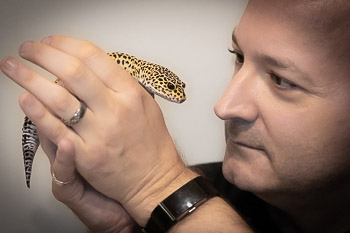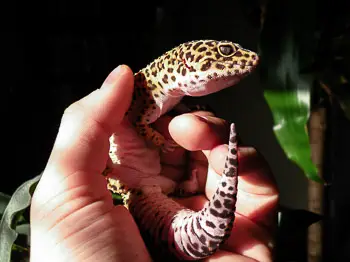Leopard geckos are one of the most popular pet reptiles, as they are docile and easy to care for. Many people wonder if they can breed their own leopard geckos.
Leopard geckos are easy to breed, though takes a bit more than putting a male and female together and letting nature take its course. Leopard geckos breed under certain conditions and you’ll want to make sure you have the right setup and environment. Here is a fool-proof guide to breeding leopard geckos.
| Breeding Season | January/February through September |
| Gestation | 16 to 22 days |
| Incubation | 6 to 10 weeks |
How Do Leopard Geckos Breed?
Like most species, leopard geckos breed by mating between a male and female. The female then lays eggs, which will hatch into baby geckos. Interestingly, the temperature the egg is kept at determines the gender of the leopard gecko that hatches. This can be controlled to produce either male or female geckos (more on that later.)
In the wild, female leopard geckos lay their eggs under rocks, or under logs. When the eggs come out of the mother, they are not yet hardened and will take a while to develop their protective shell. Eggs are then left in incubation for roughly 6 to 10 weeks depending on temperature.
The eggs require a moist substrate to incubate in, or else they will shrivel and the growing gecko inside will not be able to survive.
Leopard geckos are relatively easy to breed in captivity. Let’s take a look at the process and what you need to get started.
When is Leopard Gecko Breeding Season?
Leopard gecko breeding season typically begins in January or February and can run through September (in the Northern Hemisphere.) Females may mate and lay eggs several times within a season.
What Do I Need To Breed Leopard Geckos?
To breed leopard geckos, you will need a few items:
- The geckos and the space to house them
- An Egg Box
- An Incubator Box
- Housing for Hatchlings
Let’s get into more detail:
One Male and (at least) One Female to breed
Of course, you’ll need a male and a female gecko in order for them to mate. You can boost your probability of getting a successful mating by having more than one female. This will also be easier on the females, as egg production requires significant energy and can take a toll on the females over time and shorten their life expectancy.
Leopard geckos should be at least one year of age before they reach sexual maturity and are ready to mate.
Leopard Gecko Sexing
If you’re planning to breed leopard geckos, it’s important to know how to determine the sex of a gecko.
Male leopard geckos tend to be slightly larger and have pre-anal pores above the base of their tails, which are fairly easy to spot in adult specimens.
How can you tell a male leopard gecko from a female? Males tend to be slightly larger and heavier. Males are easy to determine by the presence of e pre-anal pores, which look like a line of dots forming a V shape at the base of the tail. In addition, males have two oval shaped hemipenal bulges.
To be certain, you’ll need to look at their underside near the base of your gecko’s tail.
Females are generally a bit smaller than males, and can be identified by the absence of the pre-anal pores present in males.

A Tank for the Male Gecko
You’ll want an enclosure just for the male. A 10 gallon tank is the minimum size for an adult, though they will be more comfortable in a 20 gallon tank. We recommend a 20 gallon long aquarium tank, or a similar sized enclosure built for reptiles.
The male needs his own tank so that he can be introduced to the female tank for breeding, and then returned to his own enclosure. Permanently housing leopard geckos together is not preferred.
Related post: Can Leopard Geckos be Kept Together?
For particulars on how to set up a leopard gecko enclosure, check out or page on essential things your leopard gecko needs or our leopard gecko setup guide.
A Tank for the Female Gecko(s)
If you only have one female, a separate 10 gallon tank is the minimum size, though again, a 20 gallon tank would be more comfortable. You can introduce the male for breeding, then return him to his own enclosure.
If you’re planning on breeding more than one female, you’ll need at least a 20-gallon tank. Ideally, you should have ample space and hides for each gecko in the enclosure.
They need a bit of extra extra space so that when the male is introduced, they are not too cramped.
Caring for Female Leopard Geckos During Breeding
Make sure to provide calcium supplements for the females, and/or dust their feeder insects. Egg production can be draining, and the extra calcium will help the females stay in good health.
Don’t be alarmed if your female gecko stops eating or has less of an appetite. This is normal during mating season. Females may feed between ovulations or clutches, then stop eating again. It’s best to monitor them and provide ample food to replenish the fat stored in their tails when they have an appetite.
An Egg Laying Box
A shoe box or Tupperware container with a hole cut in the lid is ideal for this. Simply fill the box with moist sphagnum moss or vermiculite and keep it on the same side of the tanks as the warm hide box.
The females will naturally go inside the box to lay their eggs as it is a safe place with enough warmth that will keep the eggs healthy.
An Incubation Box
It’s recommended to have a separate incubator once the eggs are laid. Fill your incubation box with two inches of vermiculite and make sure it is warm enough (we’ll get into exact temperatures below.) The vermiculite should be moist like slightly wet sand or soil. You’ll want accurate temperature control, as incubation temperature will determine the sex of the baby leopard geckos.
You can keep your incubator box in a setup similar to your leopard gecko tanks with controlled temperature, or you could opt for a reptile egg incubator designed specifically for this purpose.


How To Encourage Leopard Geckos To Breed
Introduce the male into the female tank and monitor their behavior. If the male or female(s) becomes aggressive then you may have to wait to try again. Geckos may get territorial and show some aggression towards each other but serious violence should be avoided.
Some breeders prefer a harem setup where one male is housed with the females. This may be fine if you have ample space in your enclosure and are anticipating a large number of eggs. Still, it’s best to separate the male outside of breeding season.
Other breeders will introduce the male just for the act of mating, and return him to his own enclosure. This will put less stress on the female(s).
When the male is introduced to the female, he will hopefully begin the mating ritual. The mating ritual involves him vibrating his tail while the female stands completely still. The male, if he has successfully won the female over, will then climb on her and hold her neck with his mouth while copulating.
The actual act of mating itself is rather quick, only lasting a few minutes.
If the mating is successful, the females will begin to show signs of being gravid, or carrying eggs. Their abdomens will swell a bit, and you may be able to see the eggs through their belly.
Selective Breeding
Some breeders are strategic about which geckos they choose to breed together. By breeding leopard geckos with specific genetic traits, you can influence what traits are passed down to the offspring.
Different genetic combinations are known as morphs. Morphs are kind of like “fancy” designer leopard geckos with different coloring and patterns of spots or stripes. To read more on the topic, check out our post on leopard gecko genetics. You can get a sense of the wide variety of morphs available in or post on leopard gecko morphs.
What Do I Do With Leopard Gecko Eggs?
Leopard gecko females will lay their eggs roughly 20 days after copulation. A laying of eggs is known as a ‘clutch’ and is normally one or two eggs. A single female may lay multiple clutches in a breeding season. Once you see the female going into the egg laying box, wait a few hours before checking in the box.
You can leave the eggs in the box, though expect your hatching success to be low as opposed to moving them to an incubator. The eggs may be damaged by the adult geckos, and it’s (unfortunately) not uncommon for fresh hatchlings to be eaten by adult leopard geckos.
It’s best to move any eggs to an incubation chamber where they will not be disturbed and you have greater control over the temperature. When moving the eggs, be careful to not rotate or shake them. Make sure to place them with the same side facing up as they were in the egg box.
Place them in the incubation box, half submerging them in the vermiculite. Space them about an inch apart and make sure the lid has air holes in the top.
Some eggs may be infertile, and will remain soft. Fertilized eggs will become firmer and more leathery.
The temperate the eggs are kept at determines the sex of the gecko. This is referred to as TDSD, or temperature-dependent sex determination. Temperatures around 80 degrees will produce mostly females. Higher temperatures around 90 degrees will produce predominantly males. Median temperatures in the mid 80’s will produce a mix of males and females.

Incubation may take 6 to 10 weeks before you’re greeted by baby leopard geckos. The higher the temperature, the quicker they are more likely to hatch.
Leopard Gecko Hatchlings
Once hatched, the new geckos should be kept separate from the adults. Hatchlings will feed off the egg yolk at first. They typically will not eat until after their first shed, which should occur within the first week. At this point, they will be ready to hunt for small insects.
Juveniles may be kept together so long as they have enough space and food. Once they begin to reach maturity, they should be housed separately.
.
Wrap Up – Breeding Leopard Geckos
Leopard geckos are one of the easiest reptiles to breed and can be very rewarding to the committed owner. Before venturing into breeding your own leopard geckos, make sure you have a plan to care for the animals, and have homes planned for the baby leopard geckos. Females only lay one or two eggs at a time, though can lay several clutches in a season. This could mean quite a few babies which will all need ample space, food, and attention to thrive.






One response to “Leopard Gecko Breeding Guide (leopard gecko breeding made easy)”
Thanks for the terrific information for us.
King regards,
Demir Zacho